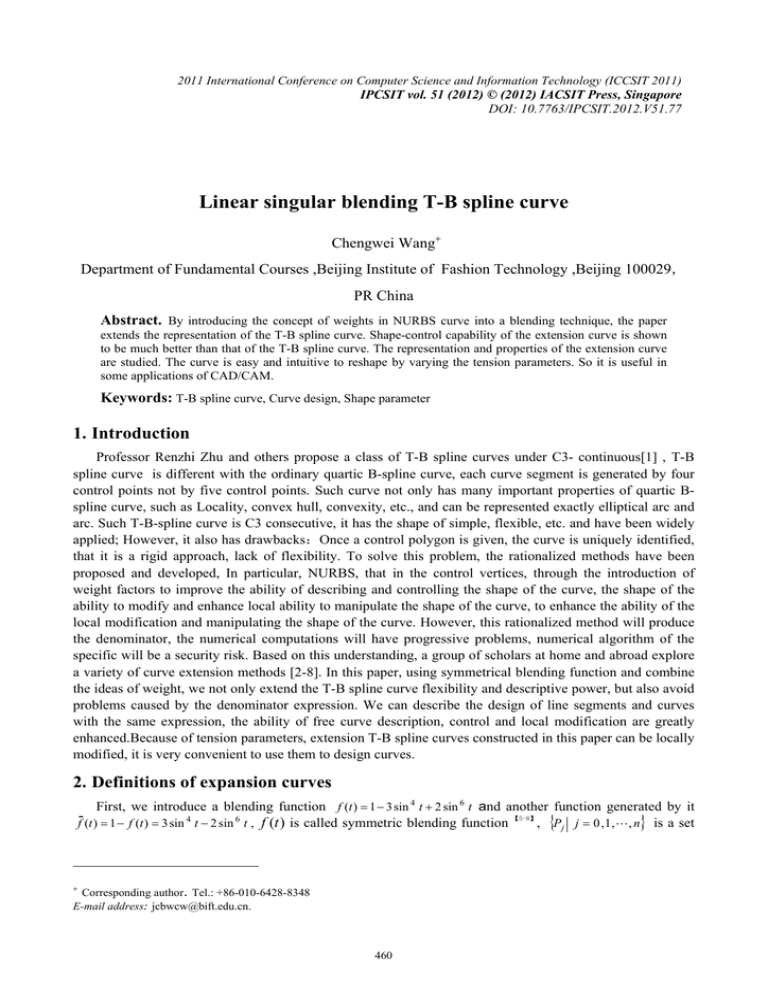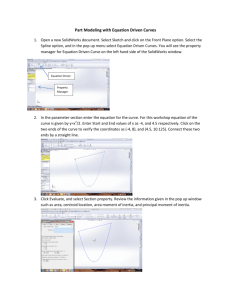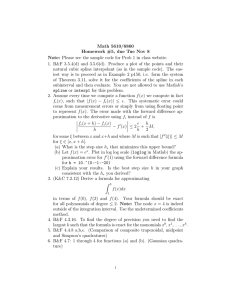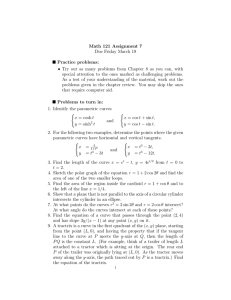Linear singular blending T-B spline curve
advertisement

2011 International Conference on Computer Science and Information Technology (ICCSIT 2011)
IPCSIT vol. 51 (2012) © (2012) IACSIT Press, Singapore
DOI: 10.7763/IPCSIT.2012.V51.77
Linear singular blending T-B spline curve
Chengwei Wang+
Department of Fundamental Courses ,Beijing Institute of Fashion Technology ,Beijing 100029,
PR China
Abstract. By introducing the concept of weights in NURBS curve into a blending technique, the paper
extends the representation of the T-B spline curve. Shape-control capability of the extension curve is shown
to be much better than that of the T-B spline curve. The representation and properties of the extension curve
are studied. The curve is easy and intuitive to reshape by varying the tension parameters. So it is useful in
some applications of CAD/CAM.
Keywords: T-B spline curve, Curve design, Shape parameter
1. Introduction
Professor Renzhi Zhu and others propose a class of T-B spline curves under C3- continuous[1] , T-B
spline curve is different with the ordinary quartic B-spline curve, each curve segment is generated by four
control points not by five control points. Such curve not only has many important properties of quartic Bspline curve, such as Locality, convex hull, convexity, etc., and can be represented exactly elliptical arc and
arc. Such T-B-spline curve is C3 consecutive, it has the shape of simple, flexible, etc. and have been widely
applied; However, it also has drawbacks:Once a control polygon is given, the curve is uniquely identified,
that it is a rigid approach, lack of flexibility. To solve this problem, the rationalized methods have been
proposed and developed, In particular, NURBS, that in the control vertices, through the introduction of
weight factors to improve the ability of describing and controlling the shape of the curve, the shape of the
ability to modify and enhance local ability to manipulate the shape of the curve, to enhance the ability of the
local modification and manipulating the shape of the curve. However, this rationalized method will produce
the denominator, the numerical computations will have progressive problems, numerical algorithm of the
specific will be a security risk. Based on this understanding, a group of scholars at home and abroad explore
a variety of curve extension methods [2-8]. In this paper, using symmetrical blending function and combine
the ideas of weight, we not only extend the T-B spline curve flexibility and descriptive power, but also avoid
problems caused by the denominator expression. We can describe the design of line segments and curves
with the same expression, the ability of free curve description, control and local modification are greatly
enhanced.Because of tension parameters, extension T-B spline curves constructed in this paper can be locally
modified, it is very convenient to use them to design curves.
2. Definitions of expansion curves
First, we introduce a blending function f (t ) = 1 − 3 sin 4 t + 2 sin 6 t and another function generated by it
【5-8】
f (t ) = 1 − f (t ) = 3 sin 4 t − 2 sin 6 t , f (t ) is called symmetric blending function
, {Pj j = 0 ,1, " , n} is a set
+
Corresponding author. Tel.: +86-010-6428-8348
E-mail address: jcbwcw@bift.edu.cn.
460
of points in three-dimension space, and a set of real numbers corresponds with points of this space
α *j 0 ≤ α *j ≤ 1, j = 1, 2 , ", n − 1 , they are called tension parameters.
{
}
Denote
L j = Pj f (t ) + Pj +1 f (t ) , j = 1, 2 , " , n − 1
(1)
It is defined singular line segment between two adjacent points in the space,then we use blending
function and the given real numbers to define a set of local blending function
α j (t ) = α *j f (t ) + α *j +1 f (t ) , j = 1, 2 , " , n − 1
(2)
Let a set of points {Pj j = 0 ,1, " , n} , in the space be the control polygon vertices,then the T-B spline
【1】
curve
is
(3)
B j (t ) = P j −1b0 (t ) + P j b1 (t ) + P j +1b2 (t ) + P j + 2 b3 (t ) j = 1, 2 ," , n − 1 ; t ∈ [0 , π / 2]
where
1
1
⎧
2
⎪b0 (t ) = 12 (3 − 4 sin t − cos 2t ) = 6 (1 − sin t )
⎪
1
1
⎪b1 (t ) = (3 + 4 cos t + cos 2t ) = (1 + cos t ) 2
⎪
12
6
⎨
1
1
⎪ b2 (t ) = (3 + 4 sin t − cos 2t ) = (1 + sin t ) 2
12
6
⎪
1
1
⎪
2
⎪⎩ b3 (t ) = 12 (3 − 4 cos t + cos 2t ) = 6 (1 − cos t )
(4)
Such that the expansion curves can be defined:
Q j (t ) = α j (t ) B j (t ) + (1 − α j (t )) L j (t ) j = 1, 2 , ", n − 2 ; t ∈ [0 , π / 2]
(5)
Since the tension parameters in the control vertices, the shape of the curve can be changed by changing
the values of these tension parameters. Therefore, these control parameters are called tension parameters,
these spline curves made by tension parameters and blending function are called α extension of the T-B
spline curve. Fig1 shows curve segments of the extension T-B spline curves.
(a)
(d)
Fig1 Five extension T-B spline curves: (a)
(b)
(c)
α1* = 0.8 , α 2* = 0.8 ;
(e)
(e)
(b)
α1* = 0.5, α 2* = 0.5 ;
α1* = 1,α 2* = 1 .
(c)
α1* = 0.9, α 2* = 0.2 ;
(d)
α1* = 0.2, α 2* = 0.9 ;
*
From fig1, it can be seen: Starting point of the* curve is* nearer P1 when the smaller α 1 is , starting point
of the curve is more far* from P1 when the larger α 1 is ; α 2 is smaller, terminal point of the curve
is nearer
P2 when the smaller α 2 is, terminal point of the curve is more far from P2 when the larger α 2* is . When
α 1* or α 2* increases, curve is far from the control polygon, when α 1* = α 2* = 1 , the extension curve degenerate
into the T-B spline curve.
3. Bases expression of expansion curves
By (5), extension T-B spline curves can be written as follows.
Q j (t ) = α j (t ) B j (t ) + (1 − α j (t )) L j (t ) =
461
α j (t )[ Pj −1b0 (t ) + Pj b1 (t ) + Pj +1b2 (t ) + Pj + 2 b3 (t )] + (1 − α j (t ))[ Pj f (t ) + Pj +1 f (t )] =
Pj −1α j (t )b0 (t ) + Pj [α j (t )b1 (t ) + (1 − α j (t )) f (t )] + Pj +1[α j (t )b2 (t ) + (1 − α j (t )) f (t )] + Pj + 2α j (t )b3 (t )
Denote
⎧ D j ,0 = α j (t )b0 (t )
⎪ D = α (t )b (t ) + (1 − α (t )) f (t )
⎪ j ,1
1
j
j
⎨
=
+
−
(
)
(
)
(
1
D
α
t
b
t
α
,
2
2
j
j
j (t )) f (t )
⎪
⎪ D j ,3 = α j (t )b3 (t )
⎩
Where j = 1, 2 , ", n − 2 ; t ∈ [0 , π / 2] .
Blending functions
properties:
(6)
f (t ) = 1 − 3 sin 4 t + 2 sin 6 t , f (t ) = 1 − f (t ) = 3 sin 4 t − 2 sin 6 t , have the following
⎧ f (0) = 1, f (π / 2) = 0, f (π / 4) = 1 / 2, f ′(0) = f ′(π / 2) = f ′′(0) = f ′′(π / 2) = 0
⎪
⎨ f (0) = 0, f (π / 2) = 1, f (π / 4) = 1 / 2, f ′(0) = f ′(π / 2) = f ′′(0) = f ′′(π / 2) = 0
⎪ f ′′′(0) = f ′′′(π / 2) = 0,f ′′′(0) = f ′′′(π / 2) = 0
⎩
(7)
From this we can get the following theorem.
Theorem : Let {D j ,i (t ) i =0 ,1, 2 , 3} , we say that they are linearly independent if and only if
α , α *j +1 not all equal to 0.
*
j
Proof: Sufficiency. Suppose k1 , k 2 , k 3 , k 4 are four a real numbers, if
3
∑k D
i
j ,i (t )
≡ 0,
0 ≤ t ≤π /2
(8)
i =0
In (8), t = 0, π / 4, π / 2 ,according to (7) ,we have
1 *
α j (k 0 + 4k1 + k 2 ) + k1 (1 − α *j ) = 0
6
(9)
α *j + α *j +1
[(3 − 2 2 )k 0 + (3 + 2 2 )k1 + (3 + 2 2 )k 2 + (3 − 2 2 )k 3 ]
24
2 − α *j − α *j +1
+
(k1 + 3k 2 ) = 0
4
1 *
α j +1 (k1 + 4k 2 + k 3 ) + k 2 (1 − α *j +1 ) = 0
6
(10)
(11)
for (8),by derivation for t , we have
3
∑ k D′
i
j ,i (t )
≡ 0,
0 ≤ t ≤π /2
(12)
i =0
In(12),t= 0, π / 2 , according to (7) ,we have
α *j (k 2 − k 0 ) = 0
(13)
α *j +1 (k 3 − k1 ) = 0
(14)
for (12),by derivation for t , we have
3
∑ k D′′ (t ) ≡ 0,
i
j ,i
0 ≤ t ≤π /2
(15)
i =0
In(15),t= 0, π / 2 , according to (7) ,we have
α *j (k 0 − 2k1 + k 2 ) = 0
α *j +1 (k1
(16)
− 2k 2 + k 3 ) = 0
(17)
Since α *j , α *j +1 not all equal to 0, we assume α *j ≠ 0 , Hence by (13) and(16), k 0 = k1 = k 2 .
then from (9) , k 0 = k1 = k 2 =0. Assume α *j +1 ≠ 0 , we can similarly prove k1 = k 2 = k 3 = 0 ; Assume
α *j +1 = 0 , By (10), k 3 = 0 ,so {D j ,i (t ) i =0 ,1, 2 , 3} are linearly independent.
Necessity. Assume α *j = α *j +1 = 0 , then D j ,0 (t ) = 0 , D j ,3 (t ) = 0 , D j ,1 (t ) = f (t ) , D j , 2 (t ) = f (t ) ,
obviously, {D j ,i (t ) i =0 ,1, 2 , 3} are linearly dependent. It is contradictory with the condition assumption.
462
The proof is completed.
{
}
In general, D j ,i (t , α *j , α *j +1 ) i =0 ,1, 2 , 3 can be seen as the bases of the extension curves, thus extension
T-B spline curves can be expressed the bases into the form below:
3
Q j (t ) =
∑D
j ,i (t ) Pi + j −1
, t ∈ [0 , π / 2]
i =0
Because f (t ) + f (t ) ≡ 1 and
∑ b (t ) ≡ 1 , 0 ≤ b (t ) ≤ 1 , i = 0 ,1, 2 , 3 . We get
i
i
i =0
3
∑D
(18)
3
j ,i (t )
= α j (t )b0 (t ) + [α j (t )b1 (t ) + (1 − α j (t )) f (t )] + [α j (t )b2 (t ) + (1 − α j (t )) f (t )] + α j (t )b3 =
i =0
α j (t )[b0 (t ) + b1 (t ) + b2 (t ) + b3 (t )] + (1 − α j (t ))[ f (t ) + f (t )] = α j (t ) + (1 − α j (t )) = 1
From(19),we obtain that
0 ≤ α *j ≤ 1 , j = 1, 2 , ", n − 1
{D
j ,i (t ,
} , j = 1, 2 , " , n − 2
α *j , α *j +1 ) i =0 ,1, 2 , 3
(19)
are normalized bases. When
0 ≤ α j (t ) ≤ 1 ,
, since 0 ≤ f (t ) , f (t ) ≤ 1 , t ∈ [0 , π / 2] , so from (2),
from (6),
0 ≤ D j ,i (t ) ≤ 1
(20)
When the tension parameters change from 0 to π / 2 , base functions are positive. In other words, basis
have a unit decomposition .
4. Properties expression of expansion curves
Property 1. Endpoint’s properties
⎧⎪ Q ′j (0) = α *j ( Pj +1 − Pj −1 ) / 3
⎨
*
⎪⎩Q ′j (π / 2) = α j +1 ( Pj + 2 − Pj ) / 3
⎧⎪ Q ′j′ (0) = α *j ( Pj −1 − 2 Pj + Pj +1 ) / 3
⎨
*
⎪⎩Q ′j′ (π / 2) = α j +1 ( Pj − 2 Pj +1 + Pj + 2 ) / 3
⎧⎪ Q ′j′′(0) = α *j ( Pj −1 − Pj +1 ) / 3
⎨
*
⎪⎩Q ′j′′(π / 2) = α j +1 ( Pj − Pj + 2 ) / 3
Property 2. Extension T-B spline curves are of geometric invariant under affine transformation
Property 2 can be obtained by the extension T-B spline curves which are expressed by the base for the
specification, at the same time it is invariant in the parameter affine transformation.
Property 3. Extension T-B spline curves are of convex hull
When 0 ≤ α j ≤ 1 , j = 1, 2 , " , n − 1 , j-curve segment of extension Ball curves Q j (t ) exists in the convex
hull formed by the control 4 points Pj −1 , Pj , Pj +1 , Pj + 2 the whole curve exists in the convex hull formed by
all the control points.
When the tension parameters change between 0 and 1,from(20), at this time we can know that basis
have a unit decomposition with a positive . At this point extension T-B curves have convex hull.
Property 4. Extension T-B spline curves are of symmetry
The order of control polygon vertices does not affect the shape of the curve. That is
Q j (t ) = Q j (π / 2 − t ) , t ∈ [0 , π / 2]
(21)
Where Q j (t ) are the extension T-B spline curves by reversing its control polygon vertices.
Proof : We need only consider one curve segment, According to (4),we have
b0 (t ) = b3 (π / 2 − t ) , b0 (π / 2 − t ) = b3 (t ) , b1 (t ) = b2 (π / 2 − t ) , b1 (π / 2 − t ) = b2 (t ) .
Blending function f (t ) also has symmetry, that is
f (t ) = 1 − f (π / 2 − t ) ,
f (π / 2 − t ) = 1 − f (t ) = f (t ) .
For the local blending function
α j (t ) = α *j (t ) f (t ) + α *j +1 (t ) f (t ) , j = 1, 2 , " , n − 1 ,
463
When the control points are arranged in reverse order, the local blending function will become
α j (t ) = α *j +1 f (t ) + α *j f (t ) .
Therefore
α j (t ) = α *j +1 f (t ) + α *j f (t ) = α *j +1[1 − f (π / 2 − t )] + α *j f (π / 2 − t ) = α *j +1 f (π / 2 − t ) + α *j f (π / 2 − t ) =
α *j f (π / 2 − t ) + α *j +1 f (π / 2 − t ) = α j (π / 2 − t ) ,
Thus
3
Q j (t ) =
∑D
j ,i (t ) P3−i + j −1
= Pj + 2α j (t )b0 (t ) + Pj +1[α j (t )b1 (t ) + (1 − α j (t )) f (t )] +
i =0
Pj [α j (t )b2 (t ) + (1 − α j (t )) f (t )] + Pj −1α j (t )b3 (t ) = P j + 2α j (π / 2 − t )b3 (π / 2 − t ) +
P j +1 [α j (π / 2 − t )b2 (π / 2 − t ) + (1 − α j (π / 2 − t )) f (π / 2 − t )] + P j [α j (π / 2 − t )b1 (π / 2 − t ) +
(1 − α j (π / 2 − t )) f (π / 2 − t )] + Pj −1α j (π / 2 − t )b0 (π / 2 − t ) = Pj −1α j (π / 2 − t )b0 (π / 2 − t ) +
Pj [α j (π / 2 − t )b1 (π / 2 − t ) + (1 − α j (π / 2 − t )) f (π / 2 − t )] + (1 − α j (π / 2 − t )) f (π / 2 − t )] +
Pj +1 [α j (π / 2 − t )b2 (π / 2 − t ) + (1 − α j (π / 2 − t )) f (π / 2 − t )] + Pj + 2α j (π / 2 − t )b3 (π / 2 − t ) =
Pj −1 D j ,0 (π / 2 − t ) + Pj D j ,1 (π / 2 − t ) + Pj +1 D j , 2 (π / 2 − t ) + Pj + 2 D j ,3 (π / 2 − t ) = Q j (π / 2 − t ) .
So extension T-B spline curves are of symmetry.
Property
5. Extension T-B spline curves are of approximation
α *j → 0 , α *j +1 → 0
If
, extension T-B spline curves are approach its control polygon.
α *j → 0 , α *j +1 → 0
,then
If
Q j (t ) = α j (t ) B j (t ) + (1 − α j (t )) L j (t ) =
(α *j f (t ) + α *j +1 f (t )) B j (t ) + (1 − α *j f (t ) − α *j +1 f (t )) L j (t ) → 0 ⋅ B j (t ) + (1 − 0) ⋅ L j (t ) = L j (t ) =
Pj f (t ) + Pj +1 f (t ) ,
It can be seen that extension T-B spline curve has better approximation than T-B spline curve. From fig2,
we can see that extension T-B spline curves can fully coincide with the control polygon.
In fig2, α 1* = 0.7, α 2* = 0.5, α 3* = 0.7, α 4* = α 5* = 0, α 6* = 0.9 .It can be seen from fig2 that extension T-B
curves completely overlap on the line segment P4 P5 .
Fig. 2: Approximation of extension T-B curves
Property 6. Extension T-B spline curves are of locality
If you change the value of a control vertex, it only changes the shape of the curve segments near the four
Q j −2 (t ) , Q j −1 (t ) , Q j (t ) and Q j +1 (t ) ; If you change the value of a tension parameter α *j , it only changes the
shape of the curve segments near the two Q j −1 (t ) and Q j (t ) , nothing to do with the other curve segments.
This shows extended T-B spline curves also inherit very good local properties from quartic B spline
curve.
Property 7. Extension T-B spline curves are of continuity
α *j
When α *j ≠ 0 , j = 1, 2 , " , n − 1 , extended T-B spline curves are C 3 - continuous from property 1. When
= 0 , j = 1, 2 , " , n − 1 , curves pass through the point P j and P j is singular point.
5. Conclution
464
In this paper, employing a blending function, in the control vertices we introduce the tension parameters,
curves can be controlled locally by these tension parameters . When the tension parameters all equal 1,
extension cubic T-B spline curve is original T-B spline curve, therefore , extension T-B spline curve is a
generalization of T-B spline curve.
6. Fund
Supported by projects
(KM201010012010)
for
technology
developmentplan
of
Beijing
Education
Committee
7. References
[1] Renzhi Zhu , Mosong Cheng. A trigonometric-function basis algorithm for the numerical simulation of arbitrarily
curved surfaces. Journal of Computer-Aided Design & Computer Graphics, 1996, 8(2): 108-114.
[2] Xuli Han, Shengjun Liu. An extension of the cubic uniform B-spline curve. Journal of Computer-Aided Design &
Computer Graphics, 2003, 15(5): 576-578.
[3] Zhiguo Wang, Laishui Zhou, Xiaoping Wang. New method to modify NURBS curves. Chinese Journal of
Computers,2004, 27(12): 1672-1678.
[4] Qingqing Liang, Gongqin Zhu. An extension of the cubic non-u-niform B-spline curve. Journal of Hefei University
of Tech-nology: Natural Science, 2005, 28(7): 829-832.
[5] Qinyu Chen, Guozhao Wang. A class of Bézier-like curves. Computer Aided Geometric Design, 2003, 20: 29-39.
[6] Guicang Zhang, Yuan Li, Ying Wu, et al. αβ-Spline surfaces. Journal of Computer-Aided Design & Compute
Graphics, 1998, 10: 53-56.
[7] Guicang Zhang, Shaojun Cui, Huifang Feng, et al. Singular blended Bézier curve and its base representation..
Journal of Engineering Graphics, 2002, 23(4): 105-112 (in Chinese).
[8] Ping Jiang; Ying Hang. Linear singular blending C-B spline curve. Journal of Hefei University of Technology ,
2008, 31(12): 2068-2071.
465







